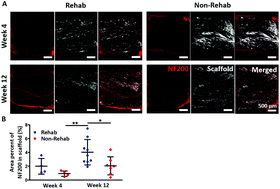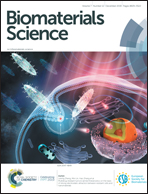Regenerative rehabilitation: exploring the synergistic effects of rehabilitation and implantation of a bio-functional scaffold in enhancing nerve regeneration†
Abstract
Clinically, rehabilitation is one of the most common treatment options for traumatic injuries. Despite that, recovery remains suboptimal and recent breakthroughs in regenerative approaches may potentially improve clinical outcomes. To date, there have been numerous studies on the utilization of either rehabilitative or regenerative strategies for traumatic injury treatment. However, studies that document the combined effects of rehabilitation and regenerative tissue engineering options remain scarce. Here, in the context of traumatic nerve injury treatment, we use a rat spinal cord injury (SCI) model as a proof of concept to evaluate the synergistic effects of regenerative tissue engineering and rehabilitation. Specifically, we implanted a pro-regenerative hybrid fiber–hydrogel scaffold and subjected SCI rats to intensive rehabilitation. Of note, the rehabilitation session was augmented by a novel customized training device that imparts normal hindlimb gait movements to rats. Morphologically, more regenerated axons were observed when rats received rehabilitation (∼2.5 times and ∼2 times enhancement after 4 and 12 weeks of recovery, respectively, p < 0.05). Besides that, we also observed a higher percentage of anti-inflammatory cells (36.1 ± 12.9% in rehab rats vs. 3.31 ± 1.48% in non-rehab rats, p < 0.05) and perineuronal net formation in rehab rats at Week 4. Physically, rehab animals were also able to exert higher ankle flexion force (∼0.779 N vs. ∼0.495 N at Week 4 and ∼1.36 N vs. ∼0.647 N at Week 12 for rehab vs. non-rehab rats, p < 0.001) and performed better than non-rehab rats in the open field test. Taken together, we conclude that coupling rehabilitation with regenerative scaffold implantation strategies can further promote functional recovery after traumatic nerve injuries.



 Please wait while we load your content...
Please wait while we load your content...